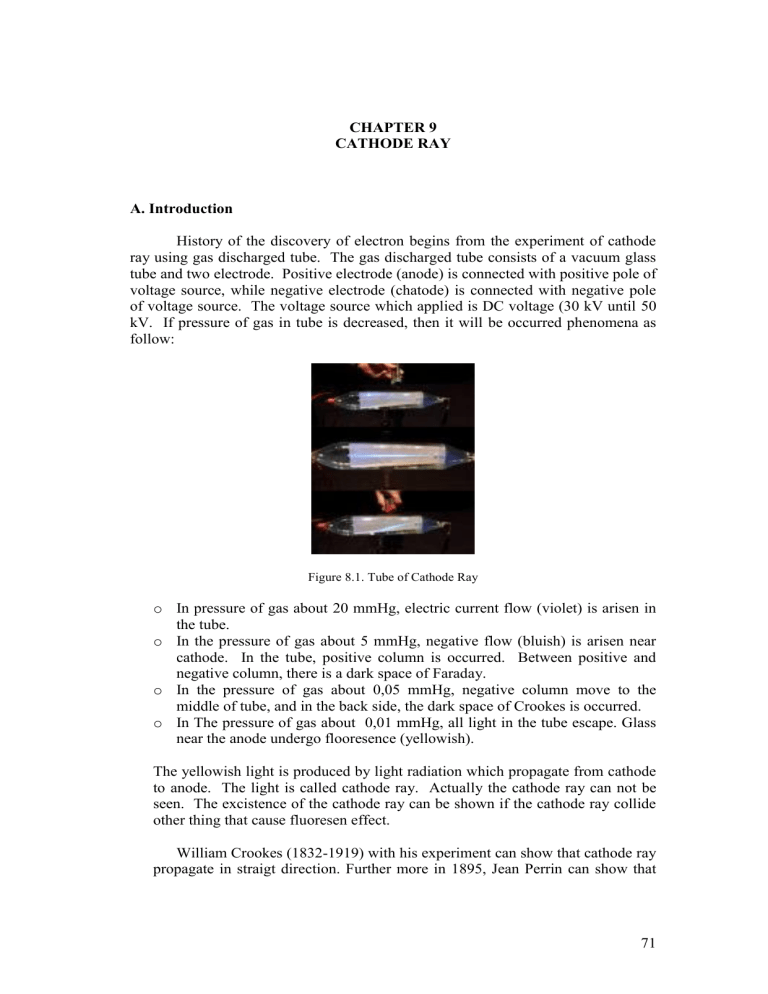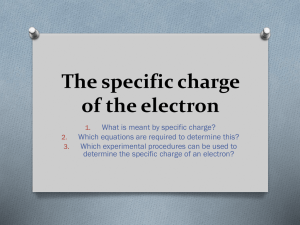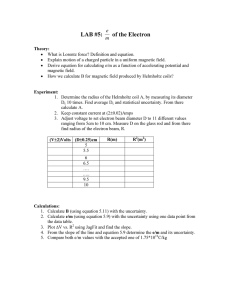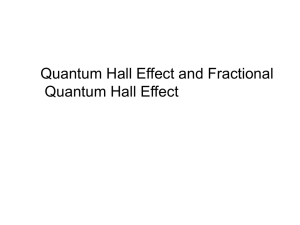History of the discovery of ... ray using gas discharged tube. The gas discharged tube... CHAPTER 9
advertisement

CHAPTER 9 CATHODE RAY A. Introduction History of the discovery of electron begins from the experiment of cathode ray using gas discharged tube. The gas discharged tube consists of a vacuum glass tube and two electrode. Positive electrode (anode) is connected with positive pole of voltage source, while negative electrode (chatode) is connected with negative pole of voltage source. The voltage source which applied is DC voltage (30 kV until 50 kV. If pressure of gas in tube is decreased, then it will be occurred phenomena as follow: Figure 8.1. Tube of Cathode Ray o In pressure of gas about 20 mmHg, electric current flow (violet) is arisen in the tube. o In the pressure of gas about 5 mmHg, negative flow (bluish) is arisen near cathode. In the tube, positive column is occurred. Between positive and negative column, there is a dark space of Faraday. o In the pressure of gas about 0,05 mmHg, negative column move to the middle of tube, and in the back side, the dark space of Crookes is occurred. o In The pressure of gas about 0,01 mmHg, all light in the tube escape. Glass near the anode undergo flooresence (yellowish). The yellowish light is produced by light radiation which propagate from cathode to anode. The light is called cathode ray. Actually the cathode ray can not be seen. The excistence of the cathode ray can be shown if the cathode ray collide other thing that cause fluoresen effect. William Crookes (1832-1919) with his experiment can show that cathode ray propagate in straigt direction. Further more in 1895, Jean Perrin can show that 71 chatode ray consist of negative charged particle. The negative particle is called electron by Thomson. According to the opinion of Thomson, electron is much lighter than atom, and electron is found in all material. It means atom is not the smallest part of matter. It gives a motivation for Thomson to propose the atomic model to repaire the atomic model of Dalton. Figure 9.2. William Crookes Based on the experiment which have been conducted, it is found some characteristic of chatode ray as follow: o o o o o o o o Propogate in straight line. It can cause zinc sulfide and barium platinasianide fluoresence It consists of negative charged particles (electron) It can produce heat It can be black of photograph film It deflects in magnetic field It deflects in electric filed It can produce x-ray Pada saat ini tabung sinar katoda dimanfaatkan untuk tabung televisi, tabung CRO, tabung sinar x, dan monitor computer. B. Lorentz Force Each charge particle (positive ion, negative ion, electron, etc) Which placed in magnetic field will get force which is called Lorentz force. The difection of this force is according to Lorentz rule (leff handed rule), if main finger shows the direction of magnetic field B, middle finger shows the motion of positive particle, then thumb shows the direction of Lorentz force. 72 Figure 9.3. Left Handed Rule (Lorentz Rule) Lorentz force which is undergone by the charge particle which move with velocity of v in magnetic fielf of B is: FL q v xB (9.1) The magnitude of Lorentz force which is undergone by charge particle is: FL qvB sin (9.2) where q is the charge of particle, and θ angle between velocity vector and magnetic field. If the charge particle move perpendicular with the direction of magnetic field, then the particle will move in circular path. In that charge particle exerts two kind of force (Lorentz force and sentripetal force). In this condition, the equilibrium force is occurred: Figure 9.4. Circular path of Electron Orbit in Magnetic Field FL Fsv2 qvB m R v2 R (9.3) mv qB Where R radius of circular path of charge particle, m mass of particle, and q charge of particle. 73 C. Motion of Charged Particle in Electric Field E The charge particle q moves in electric field E will be effected by electric field then path of particle undergoes deflection. Magnitude of electric force or Coulomb force which exerts in particle can be written: (9.4) FC qE A positive charged particle in electric field will be deflect in far away tron the direction of incident electric field. On the other hand, a negative charged particle will be deflect close to the direction of incident electric field. v v FE +q + Figure 9.5. Motion of Charged Particle in Electric Field E If charged particle move in electric field and magnetic field simaultaneusly then it will be several possibilities. One of the possibities the intensity of electric field and magnetic field is seted until the electric force and magnetic force have the same effect (in opposite direction) then the particle move in straight line. Jika muatan yang bergerak adalah elektron maka berlaku persamaan: FC FL eE evB V d Subtitute equation (9.6) in (9.5) is obtained: where E v Where V Bd (9.5) (9.6) (9.7) v : velocity of electron V: potential difference between both electrode d : distance between both electrode B: intensity of magnetic field 74 + v FE v FL -e - Figure 9.6. Motion of electron in Magnetic and Electric Field D. Thomson Experiment of Cathode Ray Based on the behavior of cagthode ray, J.J. Thomson propose that cathode ray is flowing of electrons which move from cathode to anode with high velocity. Further more, Thomson planned and conducted experiment successfully to determine ratio (e/m) of negative charged particle in the beams of cathode ray. Electron which produced by cathode that heated using filament (thermonic emission) is accelerated by potential diference of V. The speed of electron v when pass through anode can be determined based on conservation of energy as follow: 1 2 mv eV 2 or 2eV v (9.8) m where e = charge of electron m = mass of electron Electron which moves with velocity of v in perpendicular direction from homogeneus magnetic field of B, will undergoes circular motion with radius of R caused by effect of Lorentz force F = ev x B which acts as a centripetal force. mv 2 evB R or mv (9.9) eB R Based on equation (9.8) and (9.9), the ratio of e/m of electron can be determined using equation: e 2V 2 2 m r B (9.10) 75 Magnetic field which is written in equation (9.10) is produced by Helmholtz coil which consists of two parallel coil and placed coaxial with radius of R. If in Helmholtz coil is flowed by electric current I in gthe same direction, then it will be produced magnetic field in the parallel direction with the coil axis. Based on BiotSavart law, the intensity of magnetic field between both coil is: 8 0 NI (9.11) B 5 5 R where o = permeability of vacum N = turn number of coil By take o = 4. 10-7 H/m, and especially the apparatus which used in the experiment has the number of coil N = 130 turns and R = 0,150 m, then it is obtained the intensity of magnetic filed between both coil is: B = 7,793 x 10-4 I (Wb/m2) (9.12) Furthermore, substitute (9.12) in equation (9.10) is obtained : e 2V 2 m R (7,793x10 4 I ) 2 (9.13) Using equation (9.13) we can determine ratio e/m of electron. E. Deflection of Cathode Ray Experiment of JJ Thomson used a glass tube which called cathode tube. Thomson measured ratio of charge per mass of electron (e/m) with measured dflection of cathode ray in magnetic filed B. Figure 9.8. Tube of Cathode Ray In cathode ray consists of chatode and anode then electron move in straight line between both plates (upper positive plate and bottom negative plate). There is an magnetic field between anode and cathode which has downward direction. Electron (cathode ray) will undergoes an electric force in upward direction. V FE eE e d 76 Furthermore, between both plate, it also placed magnetic field which have perpendicular direction from electric field. As a consequence in electron exerts Lorentz force which has downward direction. FL evB where v is the velocity of electron. Electric voltage (V) and magnetic field (B) can be adjusted then their effect in electron are the same so that electron move in straight line. FE FL V evB d Velocity of electron can be determined: e V Bd If for a while magnetic field B is off, then it only electric field give effect. As a consequence electron will deflect upward and at the edge of plate the deflection of electron is y from plate axis. The value of deflection can be determined using equation of regular accelerated motion. v y 12 at 2 where a : acceleration t : time which required by electron to move from plate until screen (9.14) Time interval t can be determined using regular straight motion in x axis as follow: L LBd v V Where L is distance between plate until screen. t (9.15) Based on the second law of Newton, it is obtained acceleration of electron in magnetic field: FE eV m dm By substitute t and a in equation (9.14), it is obtained deflection of electron: a 2 2 2 eV LBd eV L B d y 12 2 dm V dm V 2 1 2 (9.16) e L2 B 2 d y m V 1 2 77 e 2V 2 2 m LB d (9.17) Observables:voltage V, distance from plate to screen L, intensity of magnetic field B, dan simpangan elektron pada land deflection of electron in screen y can be measured in laboratorium, then using equation (9.17), e/m is obtained: e 1,76.1011 C/kg m The more result of experiment show that: e 1,758803.1011 C/kg m F. Millikan Experiment In 1909, Robert Andrew Millikan, physicist from USA measured charge of electron successfully. Figure 9.9. Robert Andrew Millikan Several apparatus of Millikan experiment are shown in Figure 9.10. The apparatus consists of two metal plates which are arranged horizontally. Oil is sprayed pass through a small hole between both plates. Telescope is used to observe motion of oil drop between both plate. There are oil drop which move upward because it is light and move downward because it is weight. Figure 9.10. Several Aparattus of Millikan Experiment 78 If upper plate is adjusted positive potential and bottom plate is adjuste with negative potential, then electric field will be arisen between both plates. Among the oil drops is chosen negative oil drop. By adjusting potential diference between both plate the chosen oil drop does not move. In this condition, equilibrium force among weighr force, Archimedes force, and electric force is occurred. F 0 FE FA w qE ' gV mg qE ' gV gV Because: E q Vo 4 and volume V r 3 then: d 3 Vo 4 r 3 g ' d 3 (9.18) Where q : charge of oil drop Vo: potential diference between both plate g : gravity acceleration r : radius of oil drop ρ : mass density of oil ρ’: mass density of air Jika besaran-besaran Vo beda potensial antara kedua pelat; g percepatan gravitasi; r jari-jari bintik minyak; ρ massa jenis minyak; dan ρ’ massa jenis udara dapat diukur maka muatan q dapat ditentukan. The value of oil drop radius is 10-5 cm. It is too small for measure directly. To determine radiun of oil drop, Millikan let oil drop move freely without electric 79 field. Motion of Oil Drop in Electric Field FA FE w Motion of Oil Drop Without Electric Field FA FS w Figure 9.11. Force Equilibrium in Oil Drop Without electric field, oil drop will be accelerated until reach a constant velocity. In this condition exerts friction (Stokes force) between oil drop and air. In this condition, we can use the first law of Newton as follow: F 0 FA FS w Because FS 6rv so: 4 4 r 3 '6rv r 3 3 3 4 r 3 ( ' ) 6rv 3 (9.19) where η isviscosity coefisient of air and v terminal velocity of oil drop. Velocity v can be determined by meassure distance L and time interval t which required by oil drop for falling in air. If radius of oil drop can be determined, then charge of oil can be computed In his experiment, Millikan observed thousands of oil drop and got conclusion: o There is no oil drop which have charge less than elementer charge e. o All charge of oil drop always be integer number times elementer charge. Charge of oil drop which observed by Millikan are e, 2e, 3e, …, ne, where n=1,2,3,…(integer). 80 Charge of electron which was found by Millikan was: e = 1,602192.10-19 C Because charge of electron has been known, so mass of electron can be determined using equation: e 1,758803.1011 C/kg m m 1,602192 C 1,758803 C / kg 9,109543.10 31 kg m 9,11.10 31 kg G. Reference A. Haryono. 1990. Kamus Penemu. Jakarta: Gramedia Alimufi Arief, dkk. 2003. Buku Materi Pokok Fisika Atom. Jakarta: Pusbit Universitas Terbuka Anonim. 2000. E/M Apparatus EM-2N. Japan : Shimadzu Rika Instrumens Co. Ltd. Halliday dan Resnick. 1992. Fisika Jilid II (terjemahan Pantur Silaban dan Erwin Sucipto). Jakarta : Erlangga. Kanginan, M. 1996. Fisika 2B. Jakarta : Erlangga. Tim Fisika Lanjut. 2007. Petunjuk Praktikum Fisika Atom. Yogyakrta: FMIPA UNY. Wehr, M.R., et.al. 1980. Physics Of The Atom. Manila : Addison-Wesley Publishing Company. Yusman Wiyatmo. 2008. Fisika Atom dalam Perspektif Klasik, Semiklasik, dan Kuantum. Yogyakarta: Pustaka Pelajar. 81









